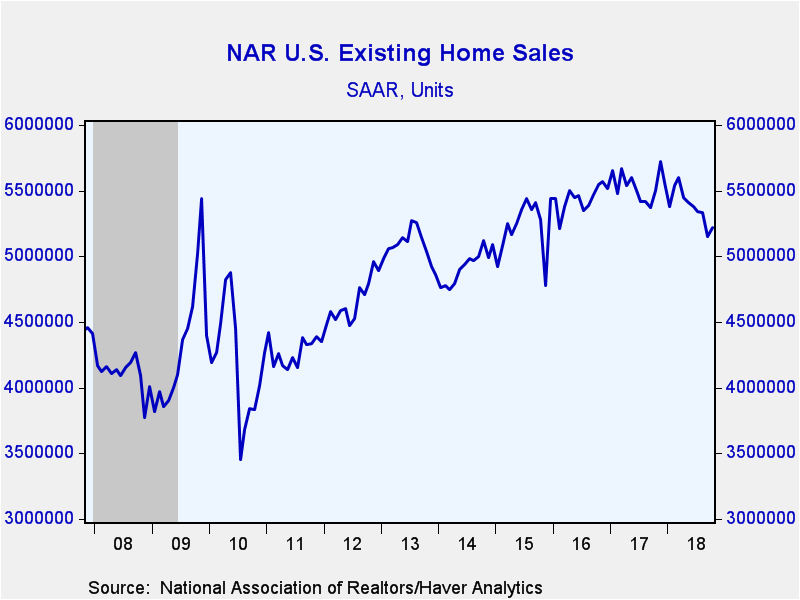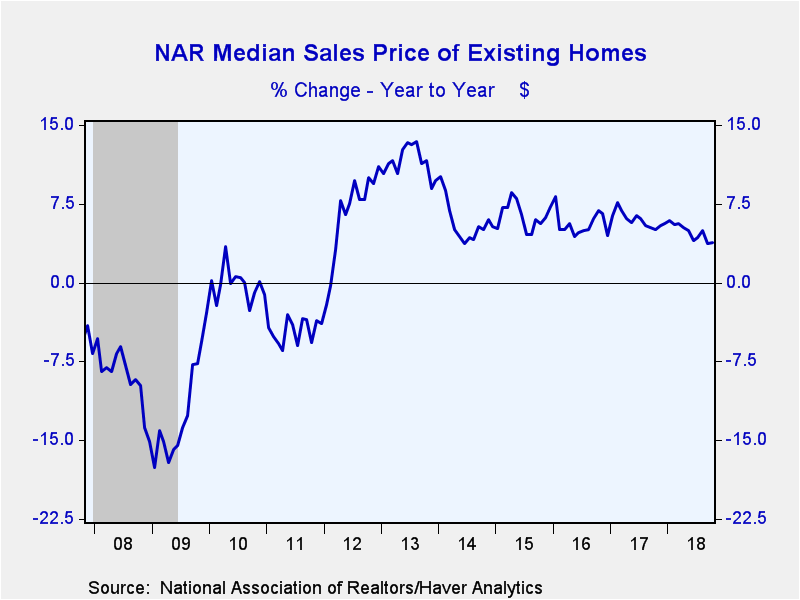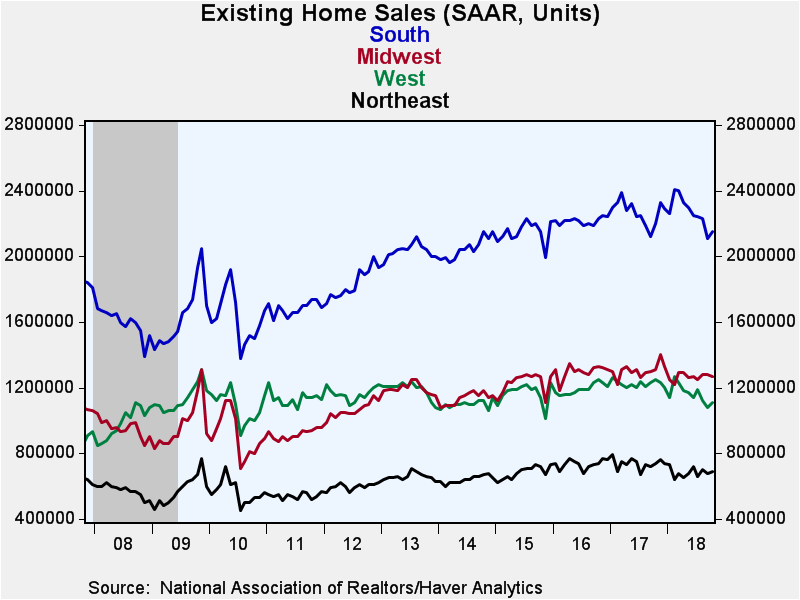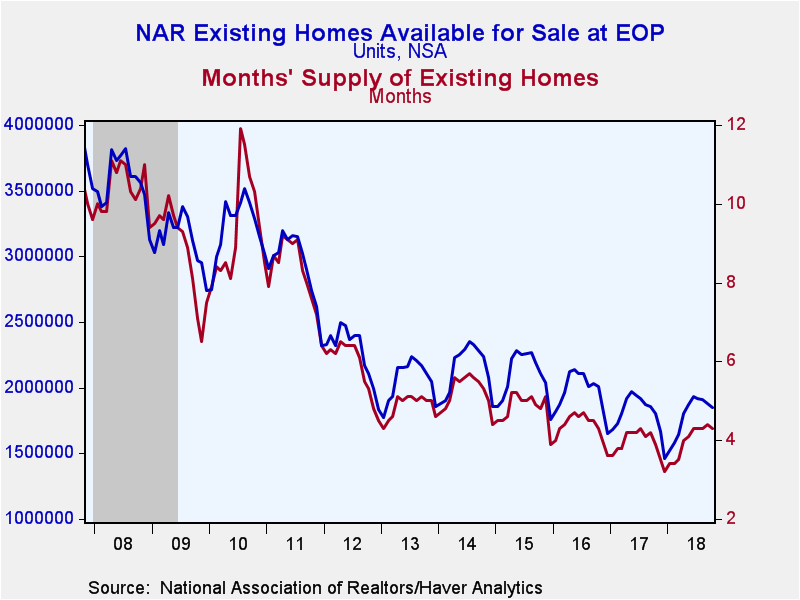 Global| Nov 21 2018
Global| Nov 21 2018U.S. Existing Home Sales Increase in October--the First in Seven Months
by:Sandy Batten
|in:Economy in Brief
Summary
The National Association of Realtors reported that sales of existing homes in October increased 1.4% m/m to 5.220 million units (SAAR) but were down 5.1% from a year earlier. The September figure was not revised. This was the first [...]
The National Association of Realtors reported that sales of existing homes in October increased 1.4% m/m to 5.220 million units (SAAR) but were down 5.1% from a year earlier. The September figure was not revised. This was the first monthly increase in sales in the past seven months. In September, sales had fallen to their lowest level since November 2015. In the Action Economics Forecast Survey, expectations had been for sales of 5.20 million units.
The median price of all existing homes sold fell further in October, declining 0.6% m/m to $255,400 for the fourth consecutive monthly decline. Prices hit a record $273,800 in June and despite the recent declines are still 3.8% higher than a year ago. The average sales price fell 0.6% m/m (+2.3% y/y) to $294,200.
Home sales in October rose in three of the four major regions. Sales in the Northeast rose 1.5% m/m (-6.8% y/y) to 690,000 units. Sales rose 1.9% m/m (-2.3% y/y) to 2.15 million units in the South and jumped 2.8% m/m (-11.2% y/y) to 1.11 million units in the West. In contrast, sales in the Midwest slipped 0.8% m/m (-3.1% y/y) to 1.27 million units.
Sales of existing single-family homes also rose in October, up 0.9% m/m (-5.3% y/y) to 4.62 million units. Sales of condos and co-ops jumped 5.3% m/m (-3.2% y/y) to 600,000 units.
The number of homes on the market fell for the fourth consecutive month, declining 1.6% m/m (NSA) in October but was 2.8% higher than a year ago. The supply of homes on the market edged down 0.1 month to 4.3 months. It has been relatively stable for the past five months and is up from the record low of 3.2 months in December 2017.
The data on existing home sales, prices and affordability are compiled by the National Association of Realtors and can be found in Haver's USECON database. The regional price, affordability and inventory data are available in the REALTOR database. The expectations figure is from the Action Economics Forecast Survey, reported in the AS1REPNA database.
| Existing Home Sales (SAAR, 000s) | Oct | Sep | Aug | Y/Y % | 2017 | 2016 | 2015 |
|---|---|---|---|---|---|---|---|
| Total | 5,220 | 5,150 | 5,330 | -5.1 | 5,536 | 5,441 | 5,228 |
| Northeast | 690 | 680 | 700 | -6.8 | 737 | 735 | 684 |
| Midwest | 1,270 | 1,280 | 1,280 | -3.1 | 1,304 | 1,298 | 1,231 |
| South | 2,150 | 2,110 | 2,230 | -2.3 | 2,270 | 2,217 | 2,147 |
| West | 1,110 | 1,080 | 1,120 | -11.2 | 1,225 | 1,192 | 1,167 |
| Single-Family | 4,620 | 4,580 | 4,740 | -5.3 | 4,910 | 4,825 | 4,623 |
| Median Price Total ($, NSA) | 255,400 | 256,900 | 265,600 | 3.8 | 245,950 | 232,067 | 219,867 |
Sandy Batten
AuthorMore in Author Profile »Sandy Batten has more than 30 years of experience analyzing industrial economies and financial markets and a wide range of experience across the financial services sector, government, and academia. Before joining Haver Analytics, Sandy was a Vice President and Senior Economist at Citibank; Senior Credit Market Analyst at CDC Investment Management, Managing Director at Bear Stearns, and Executive Director at JPMorgan. In 2008, Sandy was named the most accurate US forecaster by the National Association for Business Economics. He is a member of the New York Forecasters Club, NABE, and the American Economic Association. Prior to his time in the financial services sector, Sandy was a Research Officer at the Federal Reserve Bank of St. Louis, Senior Staff Economist on the President’s Council of Economic Advisors, Deputy Assistant Secretary for Economic Policy at the US Treasury, and Economist at the International Monetary Fund. Sandy has taught economics at St. Louis University, Denison University, and Muskingun College. He has published numerous peer-reviewed articles in a wide range of academic publications. He has a B.A. in economics from the University of Richmond and a M.A. and Ph.D. in economics from The Ohio State University.










